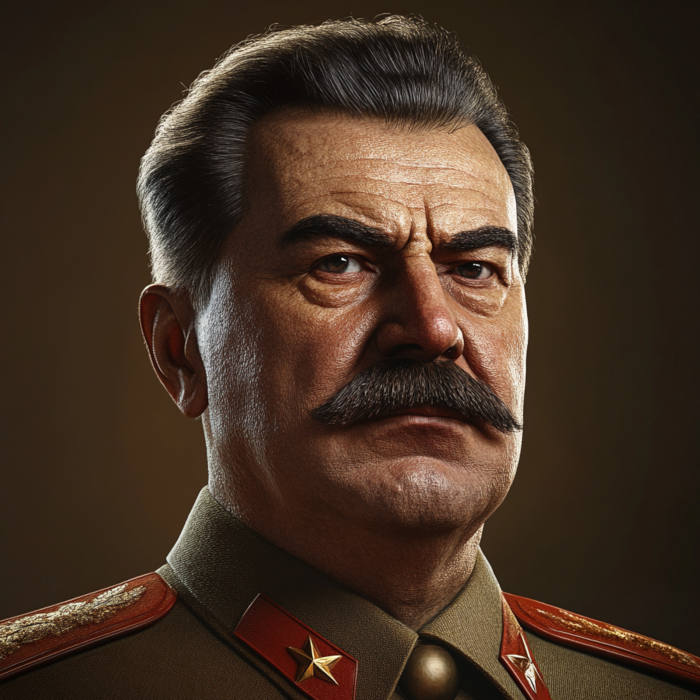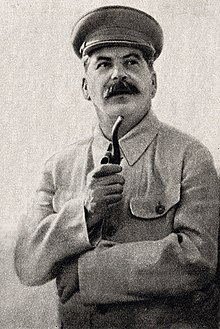


Joseph Stalin (1878–1953) was the dictator of the Soviet Union from the mid-1920s until his death in 1953. He was one of the most powerful and controversial leaders in modern history, known for transforming the Soviet Union into a global superpower through rapid industrialization, collectivization of agriculture, and the centralization of political power. His rule was marked by widespread repression, mass purges, forced labor camps, and the deaths of millions of people, making him one of the most infamous figures of the 20th century. Stalin's legacy is complex, encompassing both the modernization and industrialization of the Soviet state and the immense human suffering caused by his brutal policies.
Birth and Family Background: Joseph Stalin was born as Iosif Vissarionovich Dzhugashvili on December 18, 1878, in the small town of Gori in what is now Georgia, then part of the Russian Empire. He came from a poor family; his father was a cobbler and his mother worked as a domestic servant. Stalin's early life was marked by hardship, and he was known to be a rebellious and ambitious child.
Education and Early Marxism: Stalin attended a local church school and later enrolled at the Tiflis (Tbilisi) Theological Seminary with the intention of becoming a priest. However, during his time at the seminary, he became influenced by Marxist ideology and joined a secret socialist group. Stalin left the seminary before completing his studies and became a full-time revolutionary, participating in strikes and protests against the Russian monarchy.
Joining the Bolshevik Party: In the early 1900s, Stalin became a member of the Bolshevik faction of the Russian Social Democratic Labour Party, which was led by Vladimir Lenin. He engaged in underground revolutionary activities, including organizing strikes and bank robberies to fund the party. He also spent time in prison and was exiled to Siberia multiple times by the Russian authorities. Stalin's dedication to the cause and his organizational skills brought him to the attention of Lenin and other key Bolshevik leaders.
Role in the Russian Revolution (1917): Stalin played a relatively minor role in the October Revolution of 1917, which brought the Bolsheviks to power. After the revolution, he was appointed Commissar of Nationalities, a position that gave him authority over the many ethnic groups in the newly formed Soviet state. During the Russian Civil War (1917–1922), Stalin served as a political commissar and military leader in various campaigns, consolidating his power within the Bolshevik Party.
General Secretary of the Communist Party (1922): In 1922, Stalin was appointed General Secretary of the Communist Party, a position that, at the time, seemed administrative but allowed him to build a base of loyal supporters within the party apparatus. He carefully used this position to outmaneuver his rivals, including Leon Trotsky, who was seen as the leading contender to succeed Lenin after his death.
Lenin's Death and Stalin’s Consolidation of Power: After Lenin’s death in 1924, there was a power struggle within the Communist Party. Lenin had expressed concerns about Stalin’s character in his will, recommending that Stalin be removed from power. However, Stalin was able to outmaneuver his rivals, including Trotsky, Grigory Zinoviev, and Lev Kamenev, by forming temporary alliances and using his control over party appointments to secure his position. By the late 1920s, Stalin had effectively become the dictator of the Soviet Union.
Five-Year Plans: Once in power, Stalin launched a series of Five-Year Plans aimed at rapidly industrializing the Soviet economy and modernizing its infrastructure. These plans prioritized heavy industry, such as steel production, coal mining, and the development of transportation networks. Under Stalin’s leadership, the Soviet Union transformed from a largely agrarian society into an industrial powerhouse, laying the foundation for its emergence as a global superpower.
However, the drive for rapid industrialization came at a tremendous human cost. Workers were subjected to harsh conditions, unrealistic production quotas, and little regard for safety. While the industrialization effort succeeded in modernizing the Soviet economy, it caused widespread suffering.
Collectivization of Agriculture: Stalin’s other major economic policy was the collectivization of agriculture, which aimed to consolidate individual peasant farms into large, state-controlled collective farms. Stalin believed that collectivization would increase agricultural productivity and provide food for the growing urban workforce. However, the policy was met with fierce resistance from peasants, particularly the more affluent farmers known as kulaks, who were accused of hoarding grain and sabotaging production.
The Great Purge (1936–1938): Stalin’s rule was marked by extreme political repression. In the late 1930s, Stalin launched the Great Purge, a brutal campaign to eliminate perceived enemies of the state, both within and outside the Communist Party. High-ranking party members, military leaders, intellectuals, and ordinary citizens were arrested, tortured, and executed on charges of espionage, counter-revolutionary activities, or simply being "enemies of the people."
The purge decimated the Soviet military leadership, contributing to the Soviet Union’s initial military failures in World War II. It is estimated that hundreds of thousands, if not millions, of people were executed or sent to the Gulag labor camps during this period. Stalin’s paranoia and desire for absolute control drove much of the terror, as he eliminated any potential threats to his power.
The Gulag System: Stalin expanded the use of forced labor camps, known as the Gulag, where political prisoners, dissidents, and ordinary citizens accused of minor crimes were sent to work in brutal conditions. These camps were scattered across the Soviet Union, often in remote, harsh regions like Siberia. The Gulag system became a central part of Stalin’s repressive apparatus, with millions of people passing through the camps during his rule. Many died from overwork, starvation, or harsh treatment.
Nazi-Soviet Pact (1939): In 1939, on the eve of World War II, Stalin shocked the world by signing the Molotov-Ribbentrop Pact with Nazi Germany. This non-aggression pact allowed Hitler and Stalin to divide Eastern Europe into spheres of influence, with the Soviet Union gaining control over parts of Poland, the Baltic states, and Finland. The pact allowed Stalin to buy time to strengthen the Soviet military, though it also led to criticism from Communists and anti-fascists worldwide.
World War II and the Eastern Front: In June 1941, despite the non-aggression pact, Nazi Germany launched Operation Barbarossa, a massive invasion of the Soviet Union. The Soviet Union was initially caught off guard, and the Nazis advanced rapidly, capturing large swaths of Soviet territory. However, under Stalin’s leadership, the Soviet Union eventually turned the tide of the war, particularly after the pivotal Battle of Stalingrad (1942–1943), which marked a turning point in the conflict.
The Soviet Union played a decisive role in defeating Nazi Germany, and by the end of the war, Soviet forces had captured Berlin. Stalin emerged from World War II as a victorious leader, and the Soviet Union became one of the two global superpowers, alongside the United States.
Creation of the Eastern Bloc: After World War II, Stalin sought to expand Soviet influence over Eastern Europe, establishing communist satellite states in countries like Poland, East Germany, Hungary, Romania, and Czechoslovakia. These countries were governed by Soviet-backed communist regimes, and Stalin tightly controlled their political and economic systems, forming the Eastern Bloc.
Cold War Tensions: Stalin’s post-war policies contributed to the onset of the Cold War between the Soviet Union and the Western powers, particularly the United States. The division of Europe into communist and capitalist spheres, the Soviet blockade of West Berlin in 1948, and the arms race between the U.S. and the USSR heightened tensions during Stalin’s final years. Stalin’s determination to maintain control over Eastern Europe and expand communist influence globally set the stage for decades of geopolitical rivalry.
Declining Health and Paranoia: In his later years, Stalin became increasingly paranoid and isolated. His suspicion of those around him intensified, and he purged several close associates, including high-ranking officials. He even initiated the Doctors' Plot, a campaign accusing Jewish doctors of conspiring to assassinate Soviet leaders, though the plot was cut short by Stalin's death.
Death in 1953: Stalin died of a stroke on March 5, 1953, at his dacha (country house) outside Moscow. His death marked the end of one of the most brutal and repressive regimes in modern history. After his death, the Soviet Union underwent a period of "de-Stalinization" under Nikita Khrushchev, who denounced Stalin’s crimes and sought to reduce the cult of personality that had surrounded him.
Stalin’s Legacy in Russia and the World: Stalin’s legacy remains highly controversial. In Russia, he is both reviled and admired. Many Russians view him as the leader who transformed the Soviet Union into a global superpower, defeated Nazi Germany, and modernized the country through industrialization. However, his legacy of mass repression, political purges, forced collectivization, and the deaths of millions has left a dark stain on Russian and world history.
Globally, Stalin’s impact on the Cold War, communist movements, and the 20th century is profound. His actions shaped the geopolitical landscape for decades and contributed to the division of the world into communist and capitalist spheres of influence.
Human Cost of Stalin’s Rule: It is estimated that Stalin’s policies, including forced collectivization, the Great Purge, and the Gulag system, were responsible for the deaths of 20 million or more Soviet citizens, either through execution, forced labor, famine, or other causes. His reign of terror left deep scars on the Soviet people, and the trauma of his rule continues to resonate in Russian society.
Joseph Stalin was one of the most consequential and brutal leaders of the 20th century. His legacy is defined by both the transformation of the Soviet Union into a world power and the immense human suffering caused by his policies.

We use cookies
We use cookies and other tracking technologies to improve your browsing experience on our website, to show you personalized content and targeted ads, to analyze our website traffic, and to understand where our visitors are coming from. Privacy Policy.